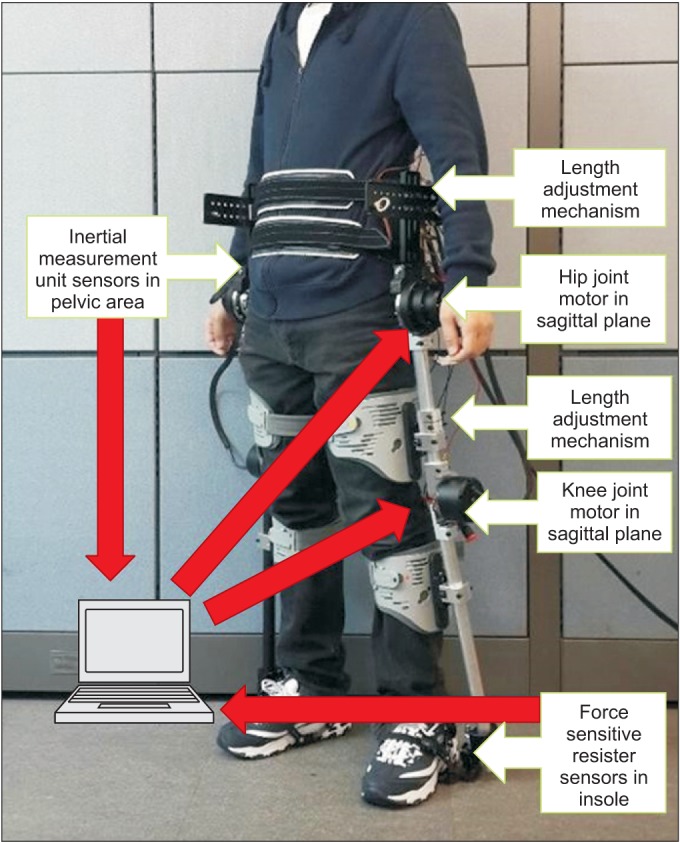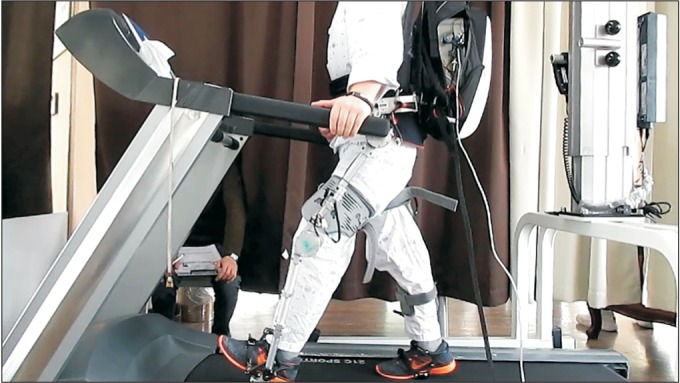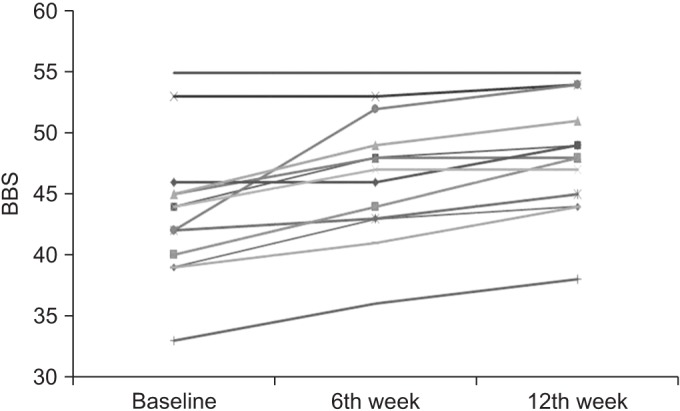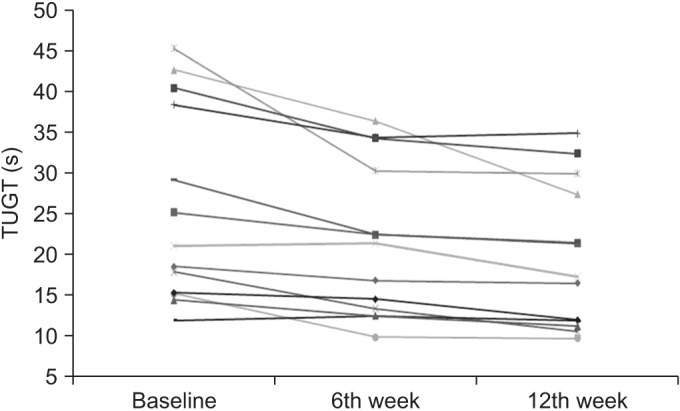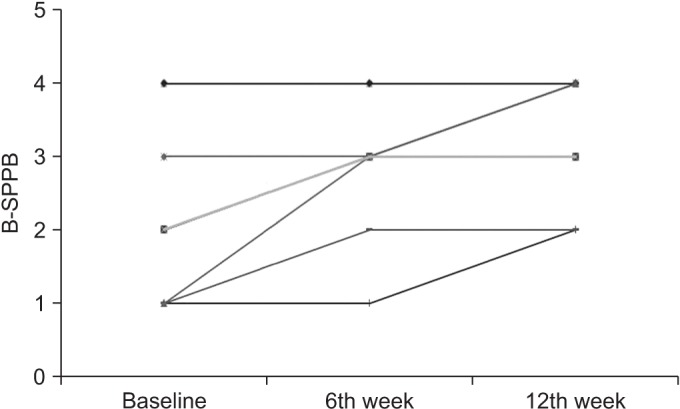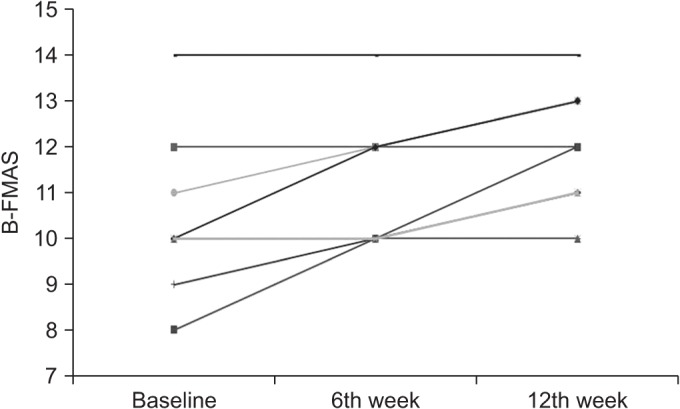Ann Rehabil Med.
2017 Apr;41(2):178-187. 10.5535/arm.2017.41.2.178.
Feasibility of Rehabilitation Training With a Newly Developed, Portable, Gait Assistive Robot for Balance Function in Hemiplegic Patients
- Affiliations
-
- 1Department of Rehabilitation Medicine, Hanyang University College of Medicine, Seoul, Korea. kimmjreh@hanyang.ac.kr
- 2Department of Rehabilitation Medicine, Rusk Bundang Rehabilitation Hospital, Seongnam, Korea.
- 3Department of Robot Engineering, CIM & Robotics Laboratory, Hanyang University, Ansan, Korea.
- KMID: 2389474
- DOI: http://doi.org/10.5535/arm.2017.41.2.178
Abstract
OBJECTIVE
To investigate the clinical feasibility of a newly developed, portable, gait assistive robot (WA-H, "˜walking assist for hemiplegia') for improving the balance function of patients with stroke-induced hemiplegia.
METHODS
Thirteen patients underwent 12 weeks of gait training on the treadmill while wearing WA-H for 30 minutes per day, 4 days a week. Patients' balance function was evaluated by the Berg Balance Scale (BBS), Fugl-Meyer Assessment Scale (FMAS), Timed Up and Go Test (TUGT), and Short Physical Performance Battery (SPPB) before and after 6 and 12 weeks of training.
RESULTS
There were no serious complications or clinical difficulties during gait training with WA-H. In three categories of BBS, TUGT, and the balance scale of SPPB, there was a statistically significant improvement at the 6th week and 12th week of gait training with WA-H. In the subscale of balance function of FMAS, there was statistically significant improvement only at the 12th week.
CONCLUSION
Gait training using WA-H demonstrated a beneficial effect on balance function in patients with hemiplegia without a safety issue.
Keyword
Figure
Reference
-
1. Moseley AM, Stark A, Cameron ID, Pollock A. Treadmill training and body weight support for walking after stroke. Stroke. 2003; 34:3006. PMID: 14615617.
Article2. Hiroyuki S, Uchiyama Y, Kakurai S. Specific effects of balance and gait exercises on physical function among the frail elderly. Clin Rehabil. 2003; 17:472–479. PMID: 12952151.
Article3. Kubota S, Nakata Y, Eguchi K, Kawamoto H, Kamibayashi K, Sakane M, et al. Feasibility of rehabilitation training with a newly developed wearable robot for patients with limited mobility. Arch Phys Med Rehabil. 2013; 94:1080–1087. PMID: 23313372.
Article4. Lunenburger L, Colombo G, Riener R, Dietz V. Biofeedback in gait training with the robotic orthosis Lokomat. In : Proceedings of the 26th Annual International Conference of the IEEE Engineering in Medicine and Biology Society (IEMBS); 2004 Sep 1-5; San Francisco, CA. p. 4888–4891.5. Neckel N, Wisman W, Hidler J. Limb alignment and kinematics inside a Lokomat robotic orthosis. In : Proceedings of the 28th Annual International Conference of the IEEE Engineering in Medicine and Biology Society (IEMBS); 2006 Aug 30-Sep 3; New York, NY. p. 2698–2701.6. Pohl M, Werner C, Holzgraefe M, Kroczek G, Mehrholz J, Wingendorf I, et al. Repetitive locomotor training and physiotherapy improve walking and basic activities of daily living after stroke: a single-blind, randomized multicentre trial (DEutsche GAngtrainerStudie, DEGAS). Clin Rehabil. 2007; 21:17–27. PMID: 17213237.7. Chen B, Ma H, Qin LY, Gao F, Chan KM, Law SW, et al. Recent developments and challenges of lower extremity exoskeletons. J Orthop Translat. 2016; 5:26–37.
Article8. Lee HD, Han CS. Technical trend of the lower limb exoskeleton system for the performance enhancement. J Inst Control Robot Syst. 2014; 20:364–371.
Article9. Ji YH, Yun DW, Jang HY, Lee DB, Khan AM, Kim S, et al. Study on efficacy of gait training for hemiplegia patients using lower-limb wearable robot. J Korean Soc Precision Eng. 2015; 32:879–883.
Article10. Oberg T, Karsznia A, Oberg K. Basic gait parameters: reference data for normal subjects, 10-79 years of age. J Rehabil Res Dev. 1993; 30:210–223. PMID: 8035350.11. Ng SS, Hui-Chan CW. The timed up & go test: its reliability and association with lower-limb impairments and locomotor capacities in people with chronic stroke. Arch Phys Med Rehabil. 2005; 86:1641–1647. PMID: 16084820.12. Fish J. Short physical performance battery. In : Kreutzer JS, DeLuca J, Caplan B, editors. Encyclopedia of clinical neuropsychology. New York: Springer;2011. p. 2289–2291.13. Blum L, Korner-Bitensky N. Usefulness of the Berg Balance Scale in stroke rehabilitation: a systematic review. Phys Ther. 2008; 88:559–566. PMID: 18292215.
Article14. Gladstone DJ, Danells CJ, Black SE. The Fugl-Meyer assessment of motor recovery after stroke: a critical review of its measurement properties. Neurorehabil Neural Repair. 2002; 16:232–240. PMID: 12234086.
Article15. Sale P, Franceschini M, Waldner A, Hesse S. Use of the robot assisted gait therapy in rehabilitation of patients with stroke and spinal cord injury. Eur J Phys Rehabil Med. 2012; 48:111–121. PMID: 22543557.16. Schwartz I, Sajin A, Fisher I, Neeb M, Shochina M, Katz-Leurer M, et al. The effectiveness of locomotor therapy using robotic-assisted gait training in subacute stroke patients: a randomized controlled trial. PM R. 2009; 1:516–523. PMID: 19627940.
Article17. Hidler J, Nichols D, Pelliccio M, Brady K, Campbell DD, Kahn JH, et al. Multicenter randomized clinical trial evaluating the effectiveness of the Lokomat in subacute stroke. Neurorehabil Neural Repair. 2009; 23:5–13. PMID: 19109447.
Article18. Calabro RS, Reitano S, Leo A, De Luca R, Melegari C, Bramanti P. Can robot-assisted movement training (Lokomat) improve functional recovery and psychological well-being in chronic stroke? Promising findings from a case study. Funct Neurol. 2014; 29:139–141. PMID: 25306125.
- Full Text Links
- Actions
-
Cited
- CITED
-
- Close
- Share
- Similar articles
-
- A Review of Robot-Assisted Gait Training in Stroke Patients
- Evaluation of Standing Balance in Hemiplegic Patients Using the Functional Reach Test
- Effects of 3-Dimensional Lumbar Stabilization Training for Balance in Chronic Hemiplegic Stroke Patients: A Randomized Controlled Trial
- Effects of Gait Training Using a Shoulder-Back Orthosis on Balance and Gait in Patients with Stroke
- Effects of Trunk Control Rehabilitation Robot Training on Dynamic Balance, Lower Extremity Strength, Gait Ability and Pain in Bipolar Hemiarthroplasty

